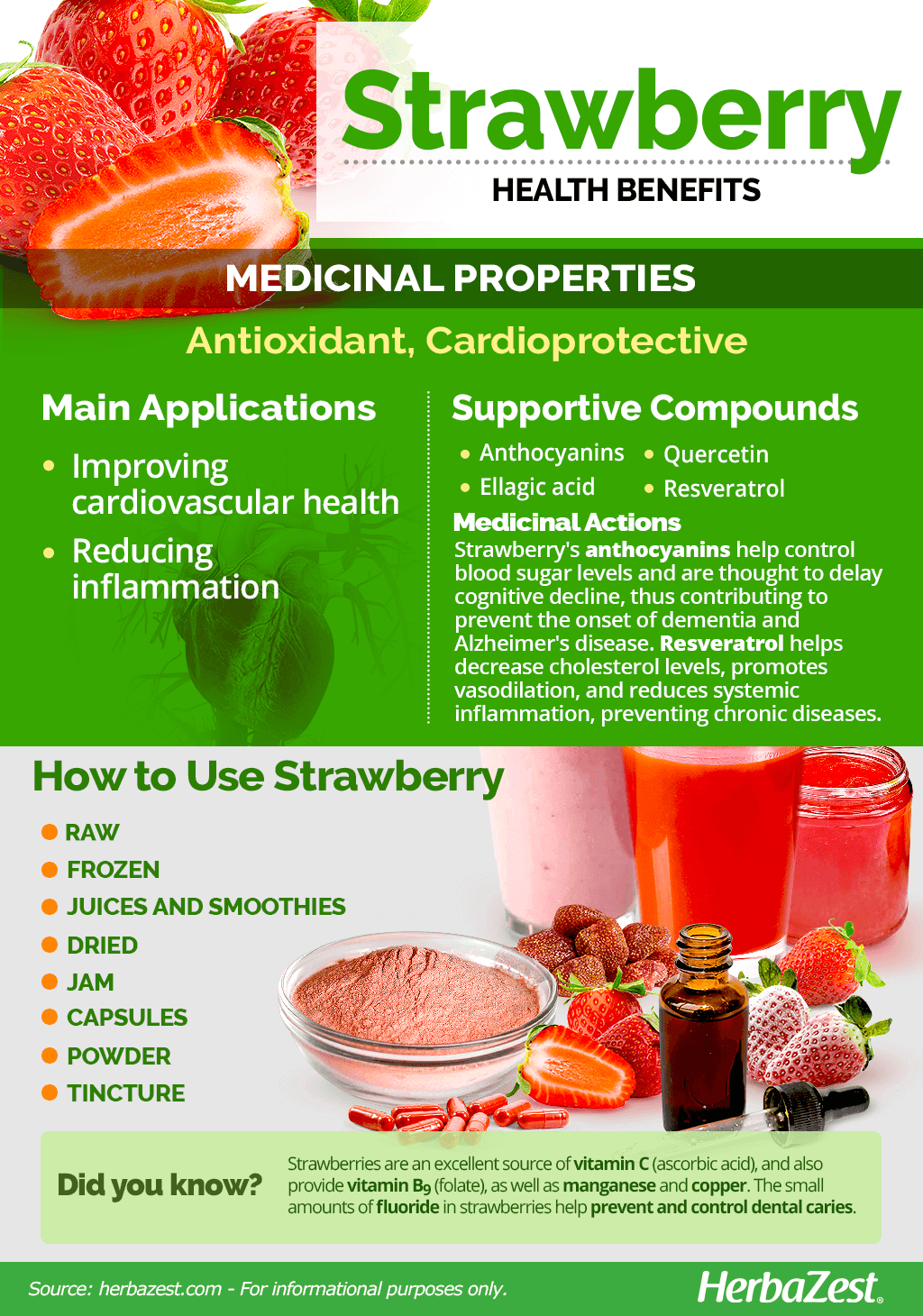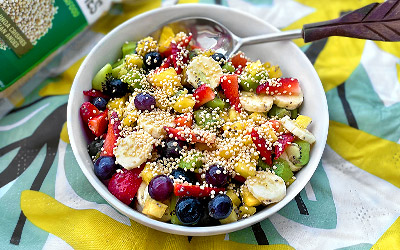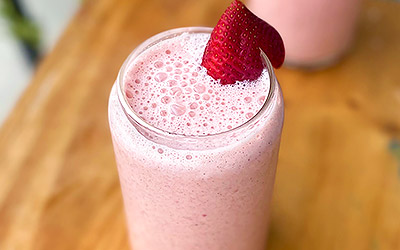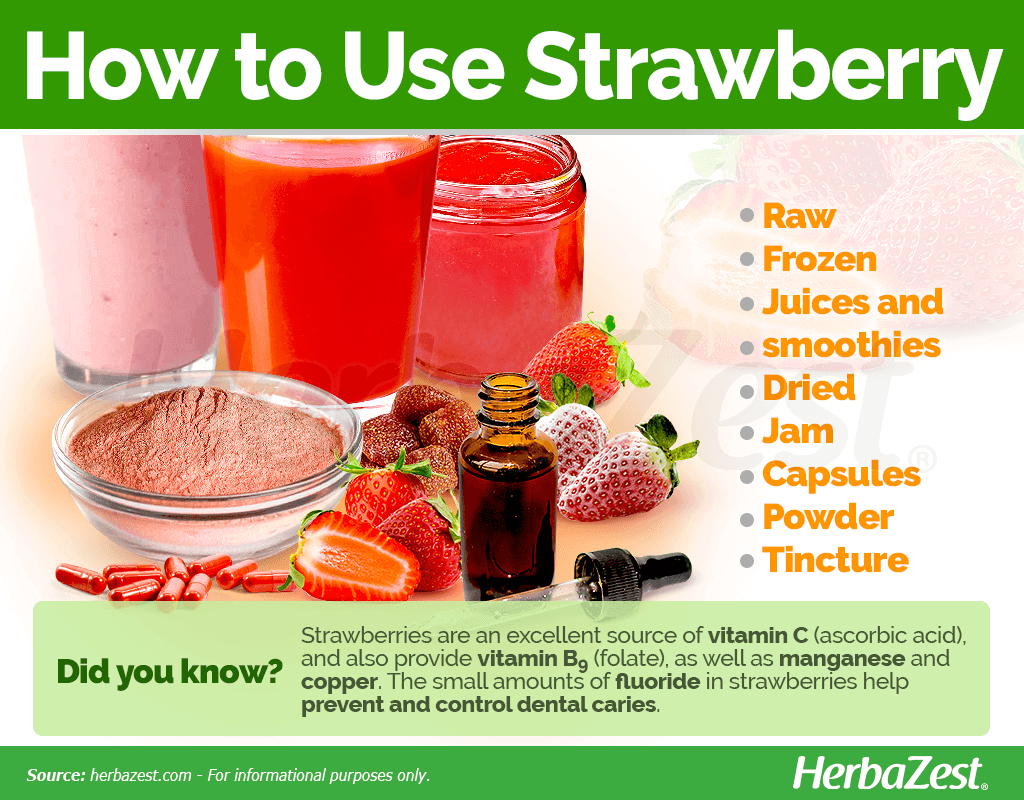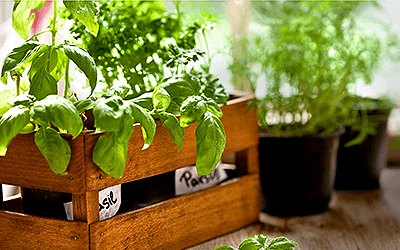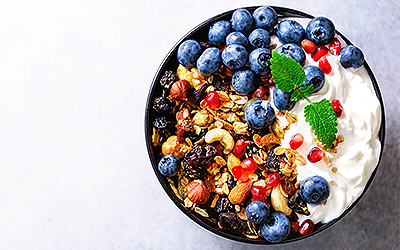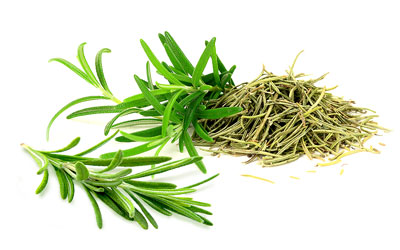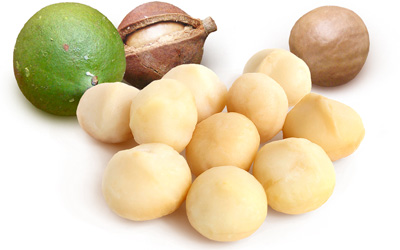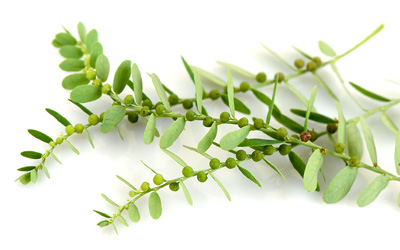Strawberries are thought to be native to four out of the seven continents: North and South America, Europe, and Asia - perhaps in part due to their ease of self-propagation and natural hardiness. Modern research has uncovered the impressive health benefits of strawberries, which make them even more desirable, beyond their juicy sweetness and nutritional profile.
Strawberry Medicinal Properties
Health Benefits of Strawberry
Modern research has dawned new and exciting light on strawberries: they are not good for health simply on the merit of being a traditionally nutritious fruit. Strawberries have shown to be useful for:
Improving cardiovascular health. Strawberries' bioactive compounds have proven effective reducing the risk of stroke, atherosclerosis, and metabolic diseases.
Reducing inflammation. The high amount of antioxidant compounds in strawberries contributes to prevent and lower systemic inflammation, thus helping reduce the risk of chronic diseases.
Strawberries may also play a role on delaying cognitive decline, mostly due to their strong antioxidant properties, which prevent cellular degeneration, one of the main causes for the development of dementia and other age-related diseases.
The leaves of strawberry were traditionally used in West Virginia as a tea for fevers and kidney stones, and the root was used as an astringent agent.
How It Works
Strawberries contain a vast and potent array of phytonutrients with great therapeutic potential, including ellagic acid, anthocyanins, resveratrol, quercetin, and catechin, which are powerful antioxidants, and have been shown to lower blood pressure, maintain blood vessel elasticity, delay memory decline, reduce cholesterol, and modulate inflammation, among a number of other benefits.
Anthocyanins, a type of flavonoids responsible for strawberries' red pigment - most likely contribute a great deal to their preventative actions. It is though that strawberry's anthocyanins are responsible for reducing sugar spikes after heavy meals, by decreasing insulin response and inflammation, as well as for delaying cognitive decline, thus contributing to prevent the onset of dementia and Alzheimer's disease.
Resveratrol, a phenolic compound with strong antioxidant properties, is higher in the seeds (achenes) than in the pulp of strawberry fruits, and it has been shown very effective in removing free radicals and other oxidant compounds, as well as in reducing low-density lipoproteins (LDL) commonly known as "bad cholesterol". Resveratrol has also exhibited cardioprotective properties, lowering the risk of blood clots -by inhibiting platelet aggregation-, promoting vasodilation, and reducing systemic inflammation by regulating the release of pro-inflammatory cytokines, thus helping hinder and prevent chronic diseases.
Strawberry supplementation in obese patients with metabolic syndrome has been shown to improve atherosclerosis risk factors by keeping in check the levels of LDL cholesterol and triglycerides.
Strawberries have been reported to reduce blood pressure and hyperglycemia.
Other herbs with cardioprotective properties are avocado and grapes, whereas beetroot and cabbage also provide anti-inflammatory benefits.
Strawberry Side Effects
As a delicious and healthy fruit, strawberry is considered generally safe in dietary amounts; however, in sensitive people, strawberry may trigger allergic reactions, including urticaria (hives) and eczema.
Cautions
Food contamination by bacteria, pesticides or fungi, is fairly common in fresh strawberries, and these fruits should be thoroughly washed and disinfected before consumption.
Likewise, caution is advised for people with iron-absorption problems and those who suffer from blood disorders, as well as for patients taking anticoagulants or blood thinner medications.
While eating strawberries in recommended dietary amounts is considered safe during pregnancy and lactation, due to insufficient evidence, pregnant women should avoid strawberry in supplemental forms, as well as eating these strawberry fruits in large amounts.
- Medicinal action Antioxidant, Cardioprotective
- Key constituents anthocyanins, ellagic acid, resveratrol, and quercetin
- Ways to use Food, Freshly ground, Juiced
- Medicinal rating (4) Very useful plant
- Safety ranking Safe
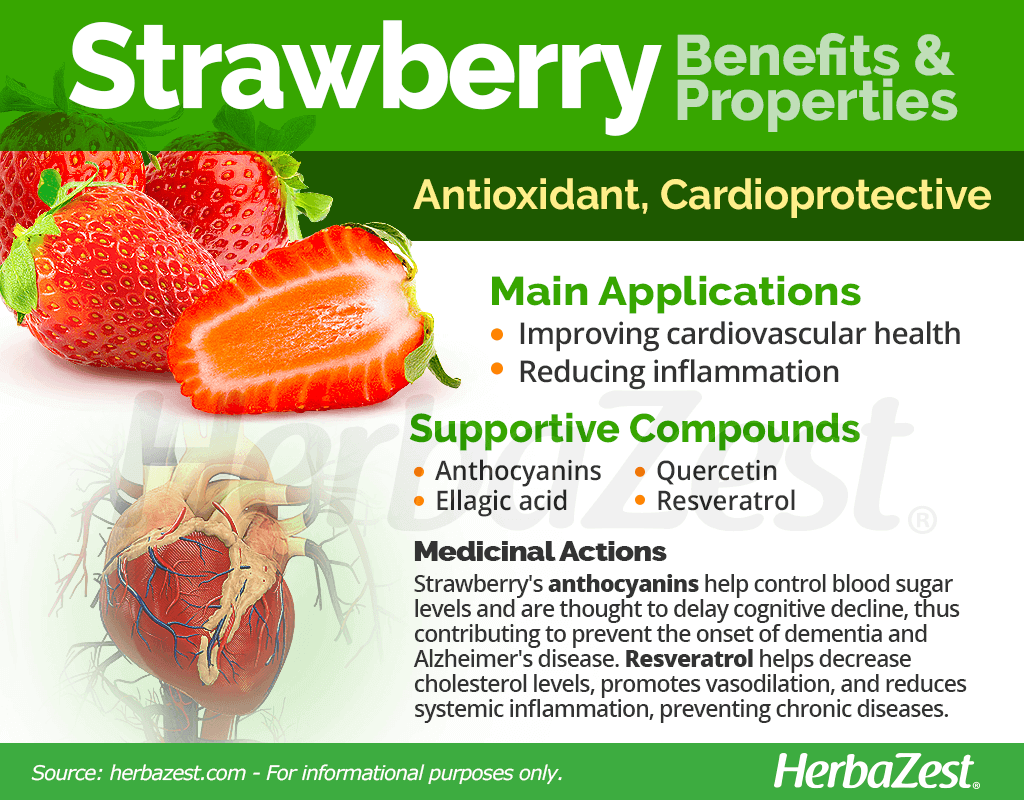
Strawberry Nutrition
Strawberries contain small amounts of fluoride, an important mineral that helps prevent and control dental caries. The adequate daily intake of fluoride in adults is of 4 mg for men, and 3 mg for women, with an upper level of 10 mg/day.
Strawberries are low in calories and carbohydrates, but provide a wide range of important nutrients, as well as dietary fiber. They offer all essential minerals, being the most important ones manganese and copper. Manganese helps with the formation of connective tissue, bones, and sex hormones, as well as with fat and carbohydrate metabolism, calcium absorption, and blood sugar regulation; whereas copper plays a role in the formation and transport of red blood cells, also supporting the health of blood vessels, nerves, immune system, and bones.
Strawberries are an excellent source of vitamin C (ascorbic acid), offering 65% of the recommended daily value, and also provide all B-complex vitamins, particularly B9 (folate), which is essential for fetal development, as well as for red blood cells production and proper iron metabolism.
100 grams of fresh, raw strawberries provide 32 calories, zero fat, and 8% of the recommended daily value for dietary fiber.
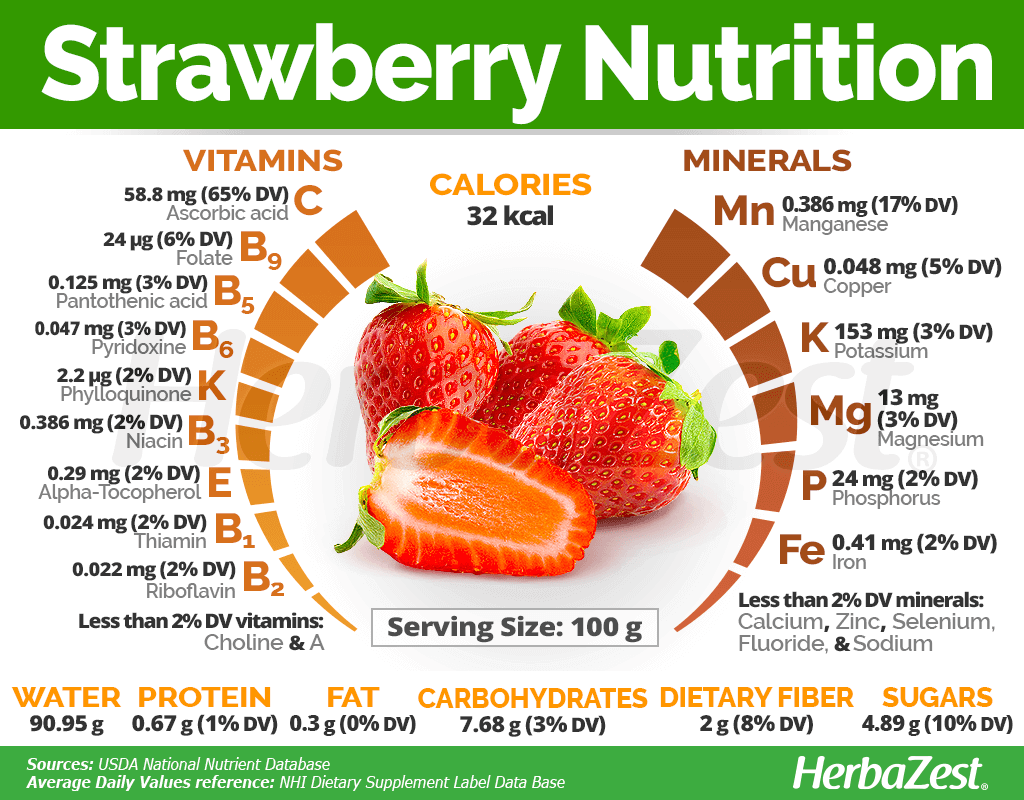
How to Consume Strawberry
Strawberries are a largely consumed fruit, and besides being eaten fresh, they have made their way into a myriad of sweet culinary recipes. They are perhaps most popular in preserves, desserts, and with dairy products. In fact, their flavor is so well-loved that strawberry extract has become a highly classic artificial flavoring.
Due to their flavor and medicinal properties, strawberries have become an intrinsic part of different cultures, being consumed with cream at Wimbledon in United Kingdom, as a Midsummer Eve dessert in Sweden, with sugar and brandy in Greece, as ice cream in Italy, and in pies in the United States.
In spite of their predominantly culinary uses, strawberry benefits and properties can also be obtained from herbal remedies and supplemental forms, which can come in handy when these seasonal fruits are not available in their fresh form.
In order to fully reap strawberry benefits, it is best to consume them in their raw, fresh form.
Natural Forms
Raw. This is the best and most popular way of reaping the health benefits of strawberries. After being thoroughly washed and disinfected, fresh strawberry fruits can be consumed whole, in salads and desserts.
Frozen. Since strawberry season is brief, the frozen fruits are a good alternative for the rest of the year. In this form, they still provide their antioxidant properties. Frozen strawberries can be added to juices and shakes, and can also be used in a variety of culinary preparations.
Juices and smoothies. Made from fresh or frozen strawberry fruits, they are chock-full of antioxidants and nutrients, particularly vitamin C (ascorbic acid). Other fruits and even leafy green vegetables can be added; popular combinations are spinach, kale, oranges, papaya, and banana.
Dried. Once dehydrated, strawberries make for a healthy snack, low in calories but full of dietary fiber and antioxidants. Dried strawberries can be found alone or mixed with other dried fruits, such as apple and pineapple. Make sure they are organic and free of added sugar.
Jam. Although water soluble nutrients, such as vitamin C (ascorbic acid) get degraded when exposed to heat, the antioxidant activity in strawberry jam doesn't change, mainly due to the presence of high levels of anthocyanins, and it can be safely preserved up to five months.
Herbal Remedies & Supplements
Capsules. Although eating fresh, raw strawberries is the best way to fully obtain their benefits and nutritional content, strawberry capsules provide antioxidant benefits in practical and standardized daily doses.
Powder. In this supplemental form, strawberry fruits are high in vitamin C (ascorbic acid) and also contribute with modest amounts of iron. The advantage of strawberry powder lies mainly in its long-shelf life and the fact that can be added to juices en smoothies.
Tincture. In this remedial form, the strawberry leaf provides its important astringent properties, which can help relief diarrhea, as well as improving liver and bladder health. Strawberry leaf tincture has been traditionally used for reducing fever, upper respiratory problems, and edema.
- Edible parts Fruit
- Edible uses Flavoring, Coloring, Beverage
- Taste Sweet
Growing
Strawberries are very easy to grow at home, as long as some requirements of soil, temperature, and light are met. Most strawberry cultivars grow well under various climatic conditions. However, temperatures below 31°F (-0.5°C) can cause severe damage to full blooms. The following tips will ensure success in the cultivation of strawberries.
Growing Guidelines
The strawberry plant is useful as a perennial in USDA zones 5 - 8, but are more typically utilized as cool season annuals in zones 9 - 10.
Strawberries grow better in deep, sandy loam soil. Avoid heavy clay or saline soils by planting them in raised beds.
When it comes to the best cultivar, everbearing and day neutral strawberries are great for gardeners with limited space. They can be grown in terraced beds, barrels or pyramids.
Strawberries can be grown from seeds, but they are most commonly propagated from runners. Planting depth is critical as too deep will rot the crown, whereas shallow planting encourages root desiccation.
Strawberries should be planted in late April or early May.
Proper irrigation is essential to maintain a healthy and productive strawberry plant. Excessive soil moisture promotes root rot, particularly on heavy soils. Salt damage can be a problem in areas with saline soils or irrigation water.
Although strawberries thrive on full sun, they can do well with some afternoon shade, as long they receive at least six hours day light.
June bearing strawberries produce a crop during a two-to-three week period in the spring.
A strawberry plant usually produces for three to five years, and is usually propagated by runners.
The best plant spacing for strawberries is 8 - 12 inches (20 - 30 cm).
Every strawberry has about 200 tiny seeds on it.
Strawberries are highly susceptible to pests, mainly nematodes, mites, slugs, and pill bugs can be production challenges;
The most common diseases that can attack the strawberry plant are leaf spots and viruses.
- Life cycle Perennial
- Harvested parts Fruit
- Light requirements Full sun, Morning sun with afternoon shade
- Soil Loamy sand
- Soil pH 6.1 – 6.5 (Slightly acidic)
- Growing habitat Temperate climates
- USDA Plant Hardiness Zones 10b, 11a, 11b, 12a, 12b
- Plant spacing average 3 m (9.84 ft)
- Potential diseases Leaf spot, Viruses
Additional Information
Plant Biology
Strawberry is a perennial herbaceous plant, with a central root that produces a varying number of short, thin vines, each with three leaves. In late spring, the plant blooms white flowers, which eventually give way to small green or white berries that turn bright red when ripe. The strawberry fruit is well-loved for its pleasing scent, vivid color, and juicy sweetness. A strawberry plant can be anywhere from 5 - 24 inches (12 - 60 cm) tall.
From a botanical point of view, the strawberry is not a fruit at all. The fleshy, edible part of the plant is the enlarged receptacle of the flower. The "seeds" that cover the surface of the strawberry are actually called achenes. An achene is a type of dry fruit borne by some plants in nature where the ripened ovary contains but a single seed.
- ClassificationThe strawberry plant (Fragaria x ananassa) is a member of the Rosaceae or rose family, which comprises about 2,830 species across 95 genera. Other well-known members of these botanical group are almond (Prunus dulcis), apple (Malus domestica), blackberry (Rubus fruticosus), pear (Pyrus communis), and prune (Prunus domestica). Fragaria x ananassa is a hybrid cultivar of two wild Fragaria species that is now is cultivated in temperate and semitropical regions worldwide. Although other Fragaria species are also cultivated, this hybrid is the primary source of commercially produced strawberries.
- Varieties and Subspecies of StrawberryToday's common strawberry garden variety, Fragaria x ananassa, was born from the hybridization of the North American F. virginiana and the Chilean F. chiloensis - a larger, albeit less sweet berry than its wild counterparts.There are over 100 different species of strawberries,and understandably, hundreds of varieties. Cultivars greatly differ in their size, color, flavor, shape, fertility, season of ripening, and susceptibility to disease. There exist many different breeding programs in order to heighten value of various factors, such as nutritional or commercial.
Historical information
The name of strawberry's genus, Fragaria, comes from the Latin word fragans, which means "fragrant".
Due to their ubiquitous presence in most continents, the exact point of origin of strawberries remains unknown. Wild strawberries have been consumed for millennia, but not in large quantities since they used to be small, tough, or flavorless. Roman poets like Virgil and Ovid mentioned the strawberry way back in the first century, but only as an ornamental, not as a food.
The first attempt to cultivate strawberries took place in France, during the 14th century, when gardeners tried to domesticate the wood strawberry (Fragaria vesca). When a North American species of strawberry (Fragaria virginiana) was introduced into Europe, in 1624, it went almost unnoticed, becoming popular in England only by the end of the 16th century. By the same time, the musky strawberry (Fragaria moschata) was also a popular sight in gardens across Europe. Eventually, the number of strawberry varieties went from three to almost thirty.
It wasn't until the 17th century that cultivated strawberries began to be commercialized, after the creation of a bigger hybrid, better suited for large scale production than wild varieties.
There are different theories regarding the origin of the common name "strawberry". Some suggest that it refers to the fact that the Fragaria plant is often mulched with straw during the winter. Another theory proposes the name strawberry as a corruption of "strewn berry", in reference to the way strawberry plant spreads, through runners, with its berries strewn about the ground. Other sources suggest that the common name of the Fragaria species refers to an old English tradition of picking wild strawberries and selling them impaled on grass straws.
Economic Data
Just as they were when wild, strawberries are an important fruit and beloved around the world. The United States is the largest producer of strawberries in the world, followed by Mexico, Turkey, Spain, and Egypt.
California is the largest producer of strawberries in the U.S., accounting for 80% of the total national strawberry production, which reached 1,366,850 tons (1,239,985 tonnes) in 2013. However, supply of fresh strawberries from California starts decreasing by the end of October, and this is where Florida, the second largest national producer, dominate the market supply. Due to the relatively mild winters, Florida is the largest supplier of fresh strawberries during the cold season.
Other Uses of Strawberry
- Industrial. Artificial strawberry flavorings and aromas are tremendously popular in many products such as lip gloss, candy, hand sanitizer, perfume, toothpaste, and more.
- Dental hygiene. Due to their fluoride content, which prevents the accumulation of dental plaque, strawberries can be used as a natural tooth bleach.
- Landscaping. With their rich lustrous dark glossy green leaves, white to pink flowers, and of course colorful delicious edible fruits, strawberries are a classic choice for home gardens and pots. They can serve as short-term small scale ground covers, or as edible accents in mixed perennial borders. Strawberries are great as winter patio plants in tempered zones.
- Alcoholic beverages. Strawberries may also be fermented into wine or liqueur (such as the Italian fragoli).
- Other uses Cosmetics, Disinfectant, Perfume
Sources
- Australian Government, National Health and Medical Research Council, Nutrient Reference Values, Fluoride (updated 2017)
- BioFactors, Breeding strawberry (Fragaria X ananassa Duch) to increase fruit nutritional quality, 2008.
- Critical Reviews in Food Science and Nutrition, Strawberry as a functional food: an evidence-based review, 2014; Potential impact of strawberries on human health: a review of the science, 2004.
- Functional Foods and Nutraceuticals, pp. 106-107
- Harvard University, Eat blueberries and strawberries three times per week; Berries keep your brain sharp
- Journal of the Science of Food and Agriculture, Effect of jam processing and storage on total phenolics, antioxidant activity, and anthocyanins of different fruits, 2011
- Library of Congress, Flok Medicine, Spring Tonics
- Natural Standard Herb & Supplement Guide, p. 687
- Nutrition Research, Strawberries decrease atherosclerotic markers in subjects with metabolic syndrome, 2011
- Oregon State University, Health and Healing Fact Sheets: Strawberries
- Purdue University, Food links, Strawberry
- Texas A&M Agrilife Extension, Aggie Horticulture, Fragaria x ananassa
- The British Journal of Nutrition, Strawberry anthocyanin and its association with postprandial inflammation and insulin, 2011
- University of Florida, Strawberry Production Around The World
- University of Kansas, Strawberry
- University of Maine, Growing Strawberries
- University of Missouri, Integrated Pest Managment, Strawberry: A Brief History
- University of Vermont, History of the Strawberry
- FAOSTAT
- Journal of Agricultural and Food Chemistry, Resveratrol Content in Strawberry Fruit Is Affected by Preharvest Conditions, 2007
